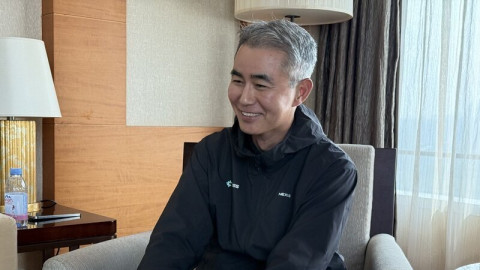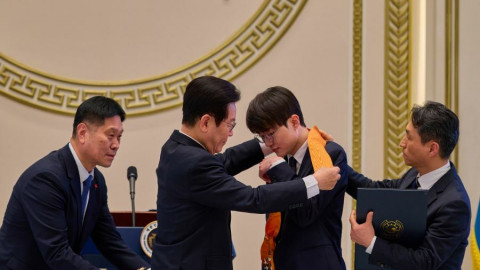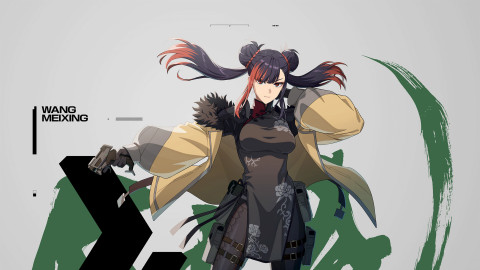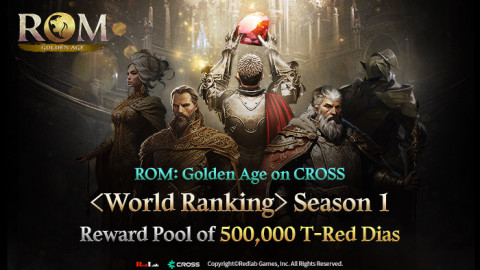A defensive fighter that maintains the initiative with his long grapple time
Since Chang Koehan has a high ATK stat of 3,938, you might think of him as an offensive fighter. However, his low DEF stat of 2,754 and HP of 33,086, the short range of his attack skills, and the close-range grapple skills make him a fighter that shines when played defensively.

In-depth analysis of the ‘basic attack’, the importance of canceling after the 1st strike
|
Smashing → Kick → Uppercut (Airborne) → Belly Thrust (Standing: Paralysis, Airborne: Knockdown)
※ Counterable with basic attack after guarding 1st-3rd strikes (Difficulty: Normal) |
Chang Koehan’s basic attacks don’t have good connections. If you mix basic attacks between skills, the connections get interrupted after the 2nd strike Kick, so you need to cancel the 2nd strike. If you start a combo with basic attacks, just use it up to the 3rd strike Uppercut.
The 4th strike, Belly Thrust, has a different effect depending on the opponent’s condition. If the opponent is in a standing state, it has a paralysis effect; if the opponent is airborne, it has a knockdown effect. If you knock down an airborne opponent, the skill connections aren’t smooth. If you hit them while standing, they will be paralyzed, so you can just continue your combo.

Chang Koehan’s skills have knockdown and airborne effects, so unless you connect them in a standing state, the opponent can roll away (dodge). As there aren’t any standing effects on Chang Koehan’s skills, and since the basic attacks’ horizontal movement is poor, it’s not suitable to connect airborne combos. That being said, when you connect combos, you must cancel the 2nd strike of the basic attack, Kick.


▲ The opponent who is airborne through Hiki Nige gets away after the 2nd strike by rolling away.
In-depth analysis of the Q skill - Tekkyuu Funsai Geki
|
- Knockdown effect - Neutralizes blast attacks
※ Counterable after guarding (Difficulty: Normal) |
Tekkyuu Funsai Geki is a triple-hit strike skill. It’s a very important attack skill for Chang Koehan. How much you land your Q skill is connected directly to your win rate. Since the skill is activated very quickly, the opponent can’t minimize the damage by using escape of emergency dodge, and you can connect combos easily on the knocked-down opponent who can’t roll away (dodge). However, as it is a close-range strike skill, it can be countered fairly easily, so you shouldn’t blindly use it against a guarding opponent.


In-depth analysis of the W skill - Dai Hakai Nage
|
- Close-range grapple skill - Smashes down opponent 8 times to both sides - 3.5-second duration
※ Counterable the moment you get grappled (Difficulty: Very Hard) Fall break (dodge) possible after 8th smash |
The pros and cons of Dai Hakai Nage are very clear. The cooldowns of all fighters’ W skills are 7.5 seconds, and Dai Hakai Nage lasts for 3.5 seconds, so it’s very useful to earn time for the cooldowns to get refreshed. However, after the 8th smash, the opponent can get away by dodging, so it would be the end of your attack turn. If the opponent dodges away after the 8th smash, it’s good to pursue them by using Hiki Nige. If the opponent avoids Hiki Nige with emergency dodge, follow up with Tekkyuu Funsai Geki.


In-depth analysis of the E skill - Hiki Nige
|
- Dashes about 70% of the screen - Standing effect - Airborne effect on last strike
※ Counterable with basic attacks/skills after guarding and before last strike (Difficulty: Easy) Emergency dodge possible before last strike |
The pros and cons of Hiki Nige are also quite clear. Since it dashes quite a long distance, it’s useful to take the opponent by surprise, but if they’re guarding, you can be countered easily. Also, unlike how it looks, it can’t neutralize blast attacks, so it’s safe to use it from close range against fighters that try to contain you with blast attacks.
The last strike has an airborne effect, so you can start a combo with it, but you need to remember that the opponent can get away with emergency dodge before the last strike. On the other hand, you can induce the opponent to use emergency dodge to gain priority in the mind game as well.



In-depth analysis of the ‘finisher’ - Iron Crusher (R)
|
1st strike: 1-hit attack after leaping about 70% of the screen (Airborne) 2nd strike: 2-hit attack while descending (Knockdown)
※ Escape+dodge possible |
The hit judgment of the 1st hit after the leap almost doesn’t make sense — it has an incredibly large hitbox. As Chang Koehan leaps through about 70% of the screen, there’s a big difference from how it looks compared to the hitbox, so if the opponent tries to avoid it by stepping backward, they’ll get squashed. Since the opponent can get away easily by using escape + dodge in the direction Chang Koehan leaped from, you need to use it when the opponent’s escape is on cooldown.
Since the knockdown effect of the 2nd strike lasts for long, you can connect Tekkyuu Funsai Geki or Hiki Nige. Hiki Nige can be avoidable by emergency dodge, so it’s recommended to connect Tekkyuu Funsai Geki (Q) → Smashing (A1) → Dai Hakai Nage (W).



In-depth analysis of the ‘ultimate’ - Iron Rampage (F)
|
- 11.5-second animation - Can’t connect combos after ultimate |
The animation time is very long, and the situation after the ultimate isn’t good for Chang Koehan. When it ends, you are face-to-face with an opponent in close range, but the opponent’s post-delay finishes first, so you can’t connect any skills. Due to this, it’s best when you use it to aim for a time over win, when you can K.O the opponent, or as the last hit of a combo.


One cycle is enough, Chang Koehan’s ‘big hit combo’
|
Smashing (A1) → Kick (A2) → Uppercut (A3) → Hiki Nige (E) → Smashing (A1) → Tekkyuu Funsai Geki (Q) → Smashing (A1) → Dai Hakai Nage (W) |
Since you can’t keep the opponent in a standing state, one cycle is no different from having a long combo. The key is to mix 1 basic attack quickly between the skills. If it’s even slightly late, the opponent can get away by dodging, so you need to be on your toes. After Dai Hakai Hage is over, and by the time the opponent rolls away, the cooldown of Hiki Nige will be refreshed within 1 second, so you can keep the initiative.

Sort by:
Comments :0







